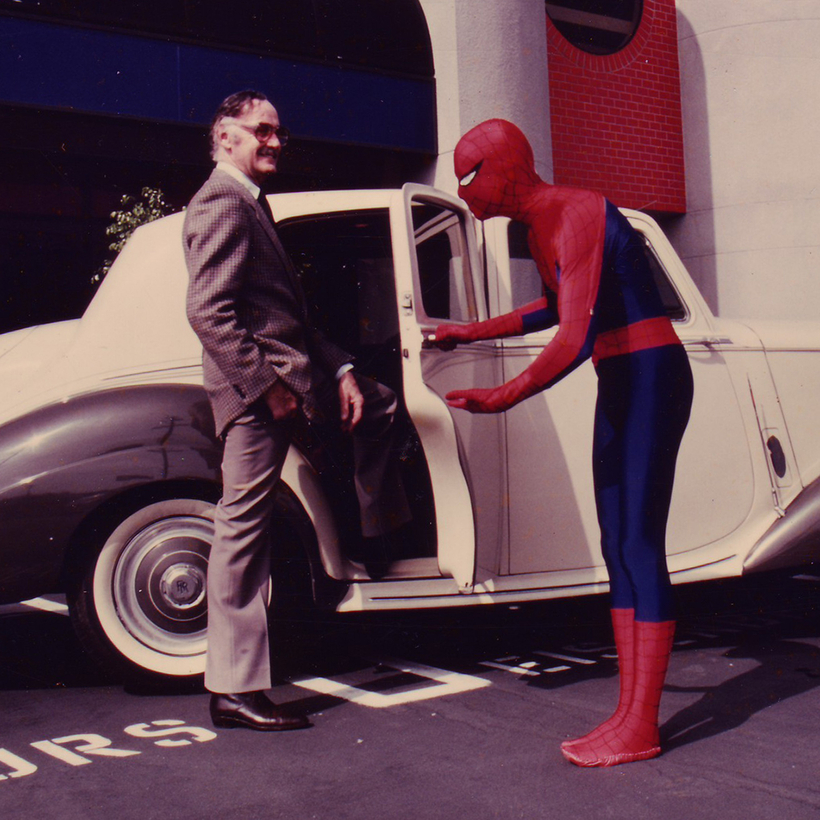I clicked Play on the old VHS machine, and even before I saw the face, I heard the voice. For countless superhero fans, that voice is instantly recognizable. It was the New York–inflected tonality of Stan Lee, the world’s most famous comic-book writer. From 1941 to 1971, Stan was the head editor and lead writer at what came to be known as Marvel Comics. While there, he claimed to have created Spider-Man, the Avengers, the X-Men, the Hulk, Black Panther, and many other iconic figures.
Those claims are now in dispute—they overlooked the many co-creators, partners, and artists also involved—but his fame isn’t, and he’s known around the world for his many cameos in movies about Marvel characters.
However, Stan, who died in 2018, was a celebrity who liked to keep his private life private. Which makes it all the more remarkable that, if you can get to Laramie, Wyoming, you can watch hours and hours of Lee-family home videos at no charge.
Smile for the Camera
In the early 1980s, the University of Wyoming’s American Heritage Center asked Stan to house his archives with them. He agreed and started periodically sending them personal and professional papers and recordings, doing so until just a few years before his death. While researching my biography of Stan, True Believer, publishing next week, I went through his archive and found a treasure trove of audio and video.
The material dated back to as early as the 1950s, with silent filmstrips taken during the first years of the Lee family’s time on Long Island, before he became well known. But most of the home-video footage came from the 80s and early 90s, after the Lees had moved to the elite Bird Streets of Beverly Hills. Once Stan bought his first camcorder, he and his family used it to obsessively document their lives in and around that home.
As I watched the videos, I was struck by a wave of sad irony. In Stan’s final years, the Lee family had descended into a horror show of conflict between parents and child, with their daughter J.C. verbally assaulting Stan and his wife, Joan, and even allegedly physically beating them in disputes over money, fame, and parental affection. But, in the videos, everyone seemed, for the most part, as happy as could be.
If you can get to Laramie, Wyoming, you can watch hours and hours of Lee-family home videos at no charge.
Joan—who died a little more than a year before Stan—was an actress and singer notorious among her friends for her love of alcohol, and, in the videos, she often appears to be tipsy and ready to break into song at any moment. The apple didn’t fall far from the tree in that regard, either, as J.C. can be just as performative in the footage. Oftentimes, the whole family would join in on these songs, evoking a harmony that would be completely lost by the end of Stan’s and Joan’s lives.
In the videos, J.C. regularly calls her father by grandiose nicknames—most often “Living Legend”—that perhaps suggest resentment over her comparative lack of fame. (Though she pursued a career as an artist and actor, she never got very far and remains known primarily as her father’s daughter.) Another layer of tragedy comes from J.C.’s onetime fiancé, a man who seemed to be passionately in love with his bride-to-be, deeply integrated into the Lee clan, and appearing often in home videos. As it turned out, the engagement would fall through and J.C. never married.
If you watch closely, there are hints of these tensions beneath the surface. Sometimes they take the form of mild irritation, such as when Stan cuts his daughter off while she’s talking or speaks to her condescendingly. Sometimes the tension is more explicit, such as in a clip from a tape made right after Joan’s 65th-birthday party in which she remarks on J.C.’s poor conduct at the soirée. In another video, J.C. narrates Stan’s dissatisfaction with her and brags about how she inherited his creative abilities while he frowns.
In Stan’s final years, the Lee family had descended into a horror show of conflict between parents and child.
But the moment that struck me the most came in a video that chronicled a pleasant day on the Lee-family deck. It begins midsentence and features a demoralized J.C. talking about her lack of greatness in comparison with her father.
“Honey, you take things as they come,” Stan tells J.C.
“I want help,” she replies.
He doubles down: “That’s like me, I take things as they come. That’s part of the greatness of being.”
She sounds utterly downtrodden as she mumbles, “But I’m not great.”
There are always multiple factors in a family breakdown, but these were at least a few of them. Nevertheless, despite knowing about all the eventual abuse that would one day come, I couldn’t help but be drawn into these bittersweet frozen moments. For the purposes of my research, the home movies were digitized for the first time, hopefully preserving them forever as a document of what one of the most beloved men of the past century was like with those who loved—and, in some ways, hated—him most.
Crown will publish Abraham Riesman’s True Believer: The Rise and Fall of Stan Lee on February 16

